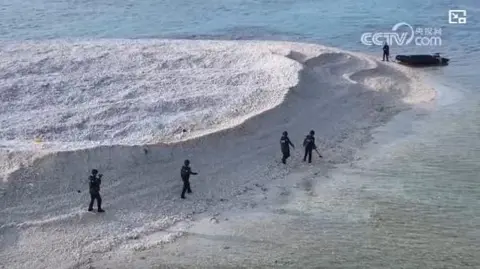Rising Tensions in the South China Sea: Flags, Sandbars, and Strategic Rivalry
The South China Sea remains one of the world’s most hotly contested regions. Recent developments have pushed tensions to new heights as China and the Philippines showcase their competing sovereignty claims, particularly over the disputed Sandy Cay sandbars. These actions not only intensify their bilateral rivalry but also draw global attention to the broader geopolitical stakes in these vital waters.

Flags as a Symbol of Sovereignty
In April 2025, both China and the Philippines made bold public gestures on Sandy Cay, a string of uninhabited sandbars in the Spratly Islands. Coast guard officers from each nation unfurled their national flags, a highly symbolic act in these disputed waters. While Chinese coast guard teams promptly publicized their presence, Philippine officials responded with their own flag-raising moments on the sandbars. These efforts underscore the persistent struggle for control in the South China Sea, an area central to territorial, economic, and strategic interests.
Read more about the standoff and symbolic flag displays on CNN.
Ongoing Confrontations and Military Posturing
The Sandy Cay incident is just the latest in an escalating series of maritime confrontations. The Philippines quickly deployed teams to nearby sandbars and highlighted the presence of both Chinese coast guard and militia vessels. This show of determination mirrored China’s assertion of what it calls “maritime control.” According to BBC reports, the situation on the sandbanks has seen rapid, back-and-forth actions by both countries, adding to an already tense military standoff in the region.
As these events unfolded, the United States and the Philippines conducted their largest-ever joint drills in the same waters. These Balikatan exercises included anti-ship missile deployments and, for the first time, full participation from Japanese forces. Military cooperation among these allies is intended to deter potential escalation and demonstrate collective resolve. The scale and scope highlight the South China Sea’s role as a flashpoint for regional—and even global—security concerns.
The Broader Geopolitical Context
At the heart of the South China Sea dispute are conflicting claims by multiple countries, including China, the Philippines, Vietnam, Malaysia, Brunei, and Taiwan. China bases its expansive claim on the so-called “nine-dash line,” a demarcation that covers most of the sea and is not recognized by international law. Over the past two decades, Beijing has built up military installations on reefs and atolls across the region, drawing sharp criticism and legal challenges.
Meanwhile, the Philippines has strengthened its military outposts and monitoring capabilities, particularly on islands like Thitu (Pag-asa). The White House has warned that moves like China’s recent sandbar seizure threaten regional stability and could violate international norms. These warnings come amid assurances that U.S. defense commitments to the Philippines remain strong.
Global Implications and the Path Forward
The South China Sea's strategic significance cannot be understated. Its sea lanes support trillions in annual trade, while its fisheries and potential energy resources are vital economic assets. Continued standoffs like those seen at Sandy Cay heighten the risk of accidental clashes or broader conflict. The actions of local players—amplified by military alliances and international responses—ensure that the region remains a delicate balancing act.
For a comprehensive look at the most recent exchanges and military movements, consult this detailed report from the BBC.
Conclusion
Tensions in the South China Sea are unlikely to recede soon. Sovereignty gestures, military deployments, and international rebukes remain the norm as countries assert their claims. Staying informed on these developments is crucial for understanding the evolving dynamics shaping the future of Asia-Pacific security and the global maritime order.